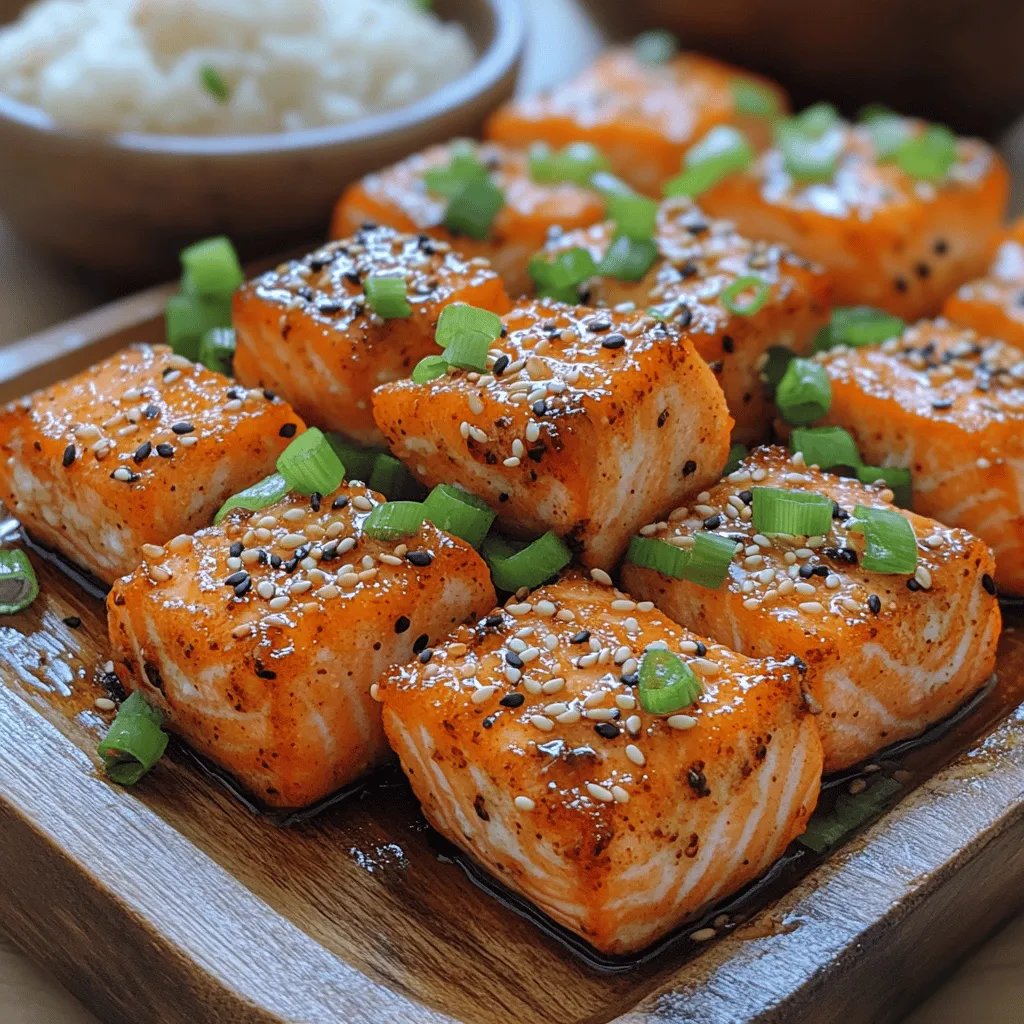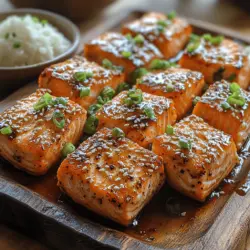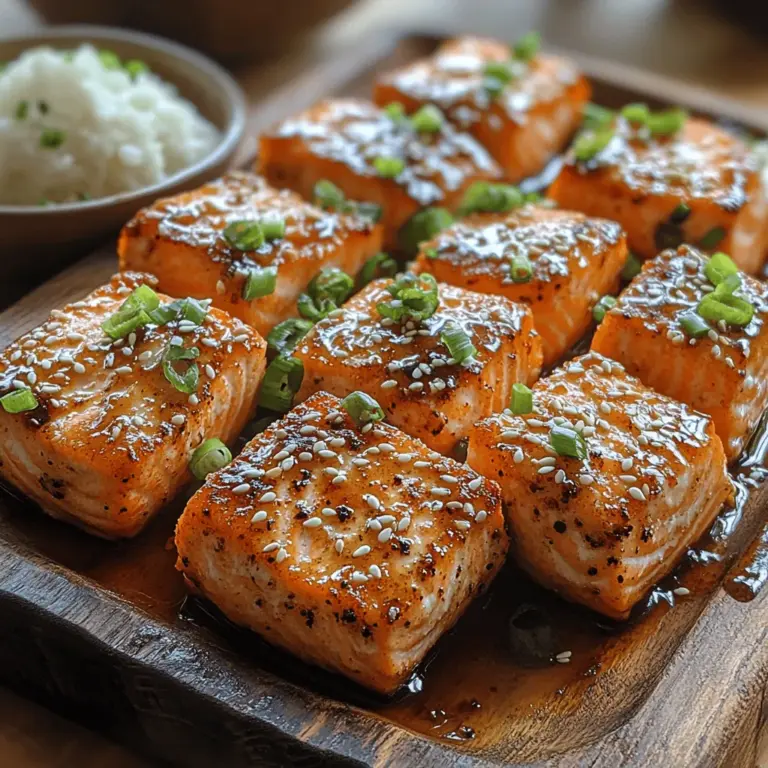Crispy Teriyaki Salmon Cubes: A Culinary Delight
In the world of culinary delights, few dishes can match the irresistible appeal of crispy teriyaki salmon cubes. This recipe showcases the perfect fusion of traditional Japanese flavors and contemporary cooking techniques, resulting in a dish that is as visually stunning as it is delicious. The salmon, with its rich, buttery texture, takes on a delightful crunch thanks to a perfectly fried coating, creating a satisfying contrast that will leave you craving more.
At the heart of this dish is the teriyaki glaze, a harmonious blend of savory soy sauce, sweet mirin, and aromatic hints of garlic and ginger. This combination not only enhances the natural flavor of the salmon but also provides a complex profile that balances sweetness and umami. Whether you’re looking to impress guests at a dinner party or simply want to treat yourself to a delicious home-cooked meal, these crispy teriyaki salmon cubes are sure to do the trick. In this article, we will guide you through the steps to create these delectable salmon bites, ensuring that you can replicate this restaurant-quality dish in the comfort of your own kitchen.
Understanding the Ingredients
To master the art of crispy teriyaki salmon cubes, it’s essential to understand the key ingredients that contribute to the dish’s unique flavor and texture. Each component plays a vital role, and knowing how they work together will elevate your cooking experience.
Fresh Salmon Fillet: The Foundation of Flavor
Salmon is not only prized for its rich taste but also for its nutritional benefits. A fresh salmon fillet serves as the star of this dish, providing a buttery texture that pairs beautifully with the crispy coating. When selecting salmon, look for vibrant color and a firm texture. Wild-caught salmon is often preferred for its superior flavor, but farmed salmon can also yield delicious results.
The Role of Soy Sauce in Teriyaki Glaze
Soy sauce is a cornerstone of teriyaki sauce, imparting a deep, savory umami flavor. It also adds a rich, dark color to the glaze that enhances the visual appeal of the dish. Opt for low-sodium soy sauce if you’re looking to control the saltiness, allowing the other flavors to shine through without overpowering the palate.
Mirin: Sweetness that Complements Savory
Mirin is a sweet rice wine that adds complexity to the teriyaki glaze. Its sweetness balances the saltiness of the soy sauce, creating a well-rounded flavor profile. Mirin also contributes a glossy finish to the sauce, making your salmon cubes not only tasty but visually appealing as well.
Brown Sugar: Enhancing the Depth of Flavor
Adding brown sugar to the teriyaki glaze introduces a layer of sweetness that enhances the overall flavor. The molasses content in brown sugar adds depth and richness, ensuring that the glaze clings beautifully to the salmon. For an alternative, consider using honey or maple syrup for a different sweet note.
The Importance of Sesame Oil in Asian Cuisine
Sesame oil is a staple in Asian cooking, known for its nutty flavor that adds warmth to dishes. A drizzle of sesame oil in your teriyaki glaze will impart a distinct aroma and richness, elevating the overall taste of the salmon cubes. Use toasted sesame oil for a more intense flavor, but be cautious not to overdo it, as its strong profile can dominate the dish.
Fresh Ginger and Garlic: Aromatics that Elevate the Dish
The combination of fresh ginger and garlic in the marinade adds an aromatic element that enhances the flavors of the salmon. Ginger provides a slight spice and warmth, while garlic contributes depth and a savory note. Using fresh ingredients is crucial, as dried versions lack the vibrancy needed to elevate this dish.
Cornstarch and Panko Breadcrumbs: The Key to Crispy Coating
To achieve that coveted crispy texture, a mixture of cornstarch and panko breadcrumbs is essential. Cornstarch helps to absorb moisture from the salmon, creating a dry surface perfect for frying. Panko breadcrumbs, known for their light and airy texture, provide an extra crunch that elevates the overall eating experience. This combination ensures that each bite of salmon is delightfully crispy on the outside while remaining tender on the inside.
Vegetable Oil: Choosing the Right Oil for Frying
When frying your salmon cubes, the choice of oil matters. Vegetable oil, canola oil, or peanut oil are excellent options due to their high smoke points, which allow for even frying without burning. These oils also neutral flavors that let the teriyaki glaze shine through, ensuring that the focus remains on the delicious salmon.
Garnishes: How Sesame Seeds and Green Onions Add the Finishing Touch
To elevate your crispy teriyaki salmon cubes, consider garnishing them with toasted sesame seeds and finely chopped green onions. These toppings not only add visual appeal but also introduce additional flavor and texture. The nutty crunch of sesame seeds complements the salmon beautifully, while green onions provide a fresh, crisp contrast that brightens the dish.
Marinating the Salmon
The next step in preparing your crispy teriyaki salmon cubes involves marination—a crucial process that ensures the salmon is infused with flavor before cooking. Marinating not only enhances the taste but also helps to tenderize the fish, making each bite even more enjoyable.
Creating a Flavorful Base
To marinate your salmon, combine soy sauce, mirin, brown sugar, sesame oil, grated ginger, and minced garlic in a bowl. This mixture will serve as the flavorful base that penetrates the salmon. Place the salmon fillets in a resealable plastic bag or a shallow dish, then pour the marinade over the fish, ensuring that each piece is well-coated.
Recommended Marination Times
For optimal flavor absorption, allow the salmon to marinate for at least 30 minutes. If you’re looking for a more intense flavor, marinating it for up to 2 hours is recommended. However, avoid marinating for too long, as the acid in the marinade can break down the fish’s texture, leading to a mushy outcome.
Tips for Perfectly Marinated Salmon
– Use Fresh Ingredients: Fresh ginger and garlic will provide a more robust flavor compared to their dried counterparts.
– Keep It Cold: Marinate the salmon in the refrigerator to prevent bacterial growth.
– Flip Occasionally: If possible, flip the bag or turn the fish halfway through the marination process to ensure even flavor distribution.
Preparing the Salmon for Frying
Once your salmon has marinated to perfection, it’s time to prepare it for frying. The key to achieving optimal crispiness lies in the drying process and the coating technique.
Patting Dry: Why It Matters
Before coating the salmon, it’s essential to pat it dry with paper towels. Moisture on the surface of the fish can hinder the frying process, preventing the coating from becoming crispy. By ensuring that the salmon is dry, you’ll create a better surface for the cornstarch and panko to adhere to, resulting in a more satisfying crunch.
Techniques for Achieving Optimal Crispiness
– Coating Process: First, dredge the salmon pieces in cornstarch, shaking off any excess. This first layer creates a barrier that helps the panko adhere better. Next, coat the salmon with panko breadcrumbs, pressing gently to ensure they stick well.
– Frying Temperature: Heat the vegetable oil in a skillet over medium-high heat. The oil should be hot enough that a breadcrumb dropped into it sizzles immediately, indicating it’s ready for frying.
– Avoid Overcrowding: Fry the salmon cubes in batches to prevent overcrowding in the pan. Overcrowding can lead to uneven cooking and a soggy texture.
With the salmon marinated, dried, and coated, you’re well on your way to creating crispy teriyaki salmon cubes that will delight your taste buds. In the next section, we will delve into the frying process, ensuring that you achieve the perfect golden-brown finish that defines this delectable dish.

The Role of Cornstarch in the Coating Process
Cornstarch is a vital ingredient in achieving the crispy exterior of your teriyaki salmon cubes. When mixed with salt, it creates a dry mix that helps absorb moisture from the salmon and promotes a delightful crunch during frying. This fine powder not only enhances the texture but also allows the salmon to develop a golden-brown crust that contrasts beautifully with the tender fish inside.
Coating the Salmon Cubes
Step-by-Step Guide to Coating
Mixing Cornstarch with Salt: The Perfect Dry Mix
To start, measure out a quarter cup of cornstarch and mix it with a teaspoon of salt in a shallow bowl. This simple combination serves as the foundation for the crispy coating. The salt enhances the flavor of the salmon while the cornstarch ensures a light, airy texture during frying. Feel free to adjust the salt according to your taste preferences or dietary needs.
How to Properly Dredge and Coat Salmon
Once your salmon cubes are cut into uniform pieces (about 1-inch cubes), it’s time to coat them. First, pat the salmon pieces dry with a paper towel to remove excess moisture. This step is crucial as it helps the coating adhere better. Take each cube and gently dredge it in the cornstarch mixture, ensuring all sides are evenly coated. Shake off any excess cornstarch before moving on to the next piece. This technique prevents clumping and ensures a uniform coating.
The Benefits of Using Panko Breadcrumbs for Extra Crunch
For an extra layer of crunch, consider adding panko breadcrumbs to your dry mix. After dredging the salmon cubes in the cornstarch, roll them in panko breadcrumbs, pressing lightly to ensure they stick. Panko, a Japanese-style breadcrumb, is coarser and airier than traditional breadcrumbs, resulting in a crispier texture when fried. This step is key to elevating your dish, providing that satisfying crunch with every bite.
Frying the Salmon
Choosing the Right Pan and Oil Temperature
For frying salmon cubes, a heavy-bottomed skillet or a cast-iron pan is ideal. These types of pans distribute heat evenly, reducing the chances of hot spots that can burn your food. Use a neutral oil with a high smoke point, such as canola or vegetable oil. Heat the oil over medium-high heat until it shimmers but is not smoking—this indicates that it’s hot enough for frying. To test the oil, drop a small piece of salmon into the pan; if it sizzles immediately, you’re ready to go.
Understanding the Frying Process: Tips for Success
When frying, it’s important not to overcrowd the pan. Adding too many salmon cubes at once can lower the oil temperature, resulting in soggy fish rather than crispy bites. Instead, cook in batches, ensuring each piece has enough space to fry evenly. This technique will help achieve that coveted crispiness on every cube.
Cooking in Batches: Why It’s Crucial for Crispiness
If you have a large batch of salmon to fry, divide it into smaller portions. Fry each batch for about 3-4 minutes on each side, or until golden brown and crispy. Using a slotted spoon or tongs, carefully flip the cubes halfway through cooking to ensure even browning. Once done, transfer the fried salmon to a plate lined with paper towels to absorb any excess oil. This simple step keeps the salmon cubes crispy until they are ready to be glazed.
Knowing When the Salmon is Done: Visual Cues and Timing
Perfectly fried salmon cubes should be golden brown and have an internal temperature of 145°F (63°C). Use a digital meat thermometer for accuracy. Visually, the salmon should be opaque throughout, with the coating appearing crispy and inviting. Keep an eye on the color; if they start to darken too quickly, reduce the heat slightly to avoid burning.
Creating the Teriyaki Glaze
Reducing the Remaining Marinade
After frying your salmon cubes, it’s time to create the delicious teriyaki glaze. Start with the marinade you set aside earlier—this will be the base for your sauce. Pour the marinade into a saucepan and bring it to a simmer over medium heat. Allow it to cook for about 5-10 minutes, or until it reduces by half. This process concentrates the flavors and thickens the sauce, making it perfect for glazing.
The Process of Simmering: How to Achieve the Right Consistency
While simmering, stir the sauce occasionally to prevent it from sticking or burning. You want the glaze to be thick enough to coat the salmon cubes but still pourable. If the sauce becomes too thick, you can always add a splash of water or broth to achieve your desired consistency. The goal is a glossy, flavorful glaze that clings to the salmon, enhancing its taste without overpowering it.
Flavor Development During Glazing
As the marinade reduces, the flavors intensify. The sweetness from the brown sugar, the umami from the soy sauce, and the hint of ginger and garlic will meld beautifully. This is the time to adjust your seasoning if necessary. Taste the glaze and decide if it needs a touch more sweetness or salt. Once you’re satisfied with the flavor, remove the saucepan from heat.
Combining and Serving the Dish
Bringing It All Together
With your salmon cubes fried and your teriyaki glaze ready, the final step is to combine the two. In a large mixing bowl, add the crispy salmon cubes and drizzle the warm glaze over the top. Using a spatula or wooden spoon, gently toss the salmon to coat each cube evenly in the glaze. Be careful not to break apart the salmon cubes during this process—gentleness is key here.
Techniques for Tossing the Salmon in Glaze
To effectively toss the salmon in the glaze, use a folding motion rather than stirring vigorously. This will help keep the salmon cubes intact while ensuring they are well coated. If you prefer a saucier dish, feel free to add more glaze to taste. This dish is all about balancing flavors and textures, so don’t hesitate to customize it to your liking.
Presentation Tips: How to Serve for Maximum Impact
Presentation plays a crucial role in any dish. To serve your crispy teriyaki salmon cubes, consider using a large platter or individual plates. Garnish the dish with sliced green onions or sesame seeds for an added touch of color and flavor. You can also serve the salmon cubes alongside steamed rice or a fresh salad to create a complete meal. For an authentic touch, serve with small bowls of extra teriyaki sauce on the side for dipping.
Suggested Pairings: Best Accompaniments for Teriyaki Salmon Cubes
Pair your teriyaki salmon cubes with a variety of sides to enhance the meal. Steamed jasmine rice or sushi rice is a classic choice that complements the sauce beautifully. For a healthier option, consider serving with a side of sautéed vegetables like bok choy or snap peas. A refreshing cucumber salad or pickled vegetables can also provide a nice contrast to the richness of the salmon. If you’re in the mood for something different, a bowl of miso soup can round out the meal perfectly.
Conclusion
Crispy teriyaki salmon cubes are not just a meal; they are an experience filled with bold flavors and enticing textures. This dish embodies the essence of Japanese cooking while allowing for creativity and personalization in the kitchen. By following the steps outlined in this article, you can create a delicious and visually appealing dish that will delight your taste buds and impress your guests. Whether served as an appetizer or a main course, these salmon cubes are sure to become a favorite in your culinary repertoire, bringing a touch of gourmet dining to your home. Enjoy the journey of creating this delectable dish, and savor every bite!

